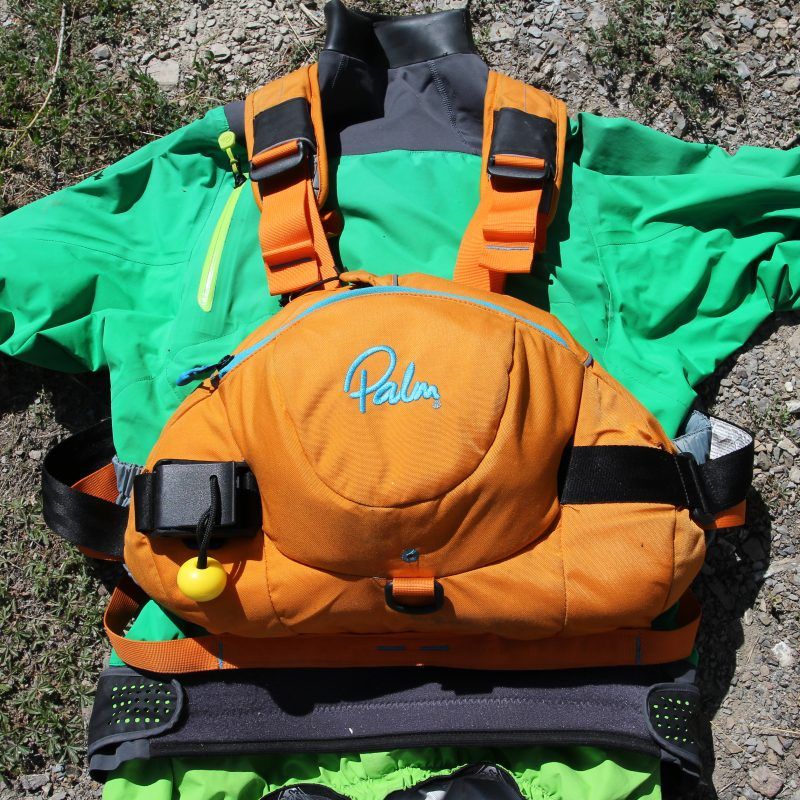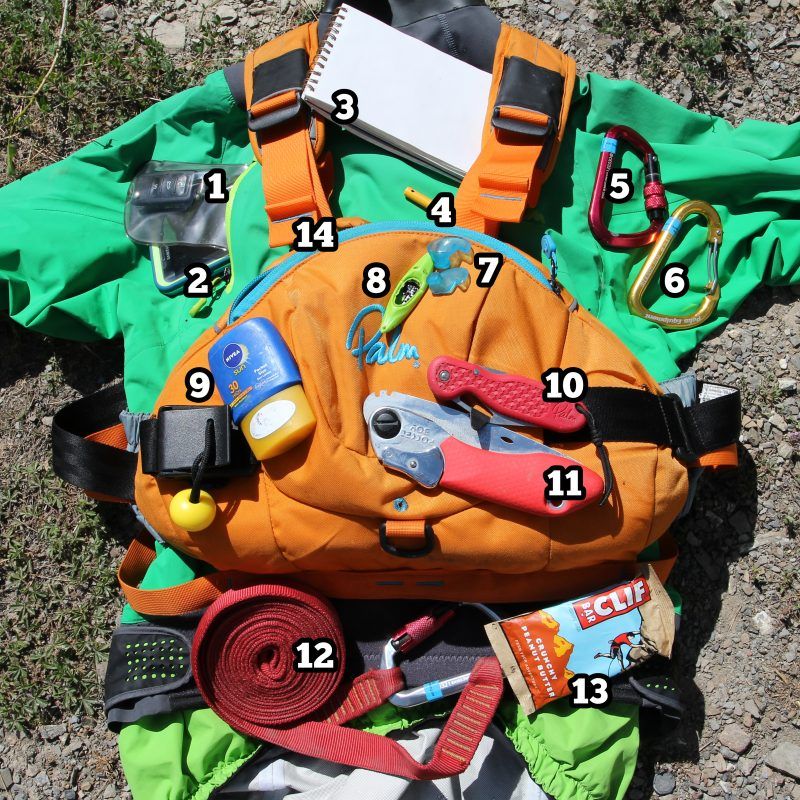Where I am, what I am doing and who I am with will ultimately influence the kit and equipment that I choose to carry. Don’t just carry the same kit everywhere – give a little thought to your day on the water and what you will be doing.
I am mindful to adopt a clean profile as much as possible. I add nothing to my PFD that can catch (such as external knife or watch) – to reduce the risk of anything snagging either in the event of a swim or when trying to get back into a boat. Of course, all of this is personal preference and what might be useful for me, might not work for you.

Over the years I have removed some items that I hardly ever used in favour of some pieces of equipment that I use regularly. However, some items that we use infrequently might still be essential (such as our knife). Here’s what I might carry if I’m paddling on whitewater …

- Keys in waterproof pouch (in cag pocket)
If I have my keys with me (rather than in my boat) I don’t risk losing them should I swim or be separated from my boat. I have been involved in several situations where the need to be able to drive my vehicle has been essential. I always have my own keys on me so that I know exactly where they are.
- Phone in waterproof Case (in cag pocket)
My phone is a super useful tool. It has phone numbers of people I might need to contact in an emergency as well as the contact details of the team that I am paddling with should we end up separated. It also has maps, GPS and even has a first aid app on there too. I keep it in a waterproof case in my cag pocket with my keys so it is out of the way of the kit I might need to get to in a hurry.
- Waterproof notebook
I work full time coaching paddlesport, so a notebook is pretty handy for gathering information and giving feedback. A notebook can also be handy in an emergency where I might need to record a casualty’s vital signs or to write down our location or critical information.
- Waterproof pencil
This one is pretty simple really, the waterproof pencil writes on the waterproof notebook! (The pencil is actually a bit fancy and is designed not to fall to pieces when it gets repeatedly wet.)
- Locking karabiner
I keep a spare locking karabiner handy as this can be easily clipped onto a throwbag and then potentially onto something else (like a boat). It is handy for making some kind of mechanical advantage system to unpin a boat. A locking karabiner should always be used if clipping into a chest harness, for example in a live bait rescue.
- Snapgate karabiner
A wide opening snapgate will clip easily over a paddle shaft. I might need to clip this snapgate to my throwbag and then to my paddle to use my paddle as a javelin if I am trying to get the rope through a curtain of water or potentially to make it easier to grab for a swimmer in a stopper.
- Earplugs
Surfers ear is a condition where bone grows slowly to close your ear canal over a long period of time due to exposure to cold jets of water being forced into our ear. You can reduce the risk of this by wearing earplugs. There are many kinds of ear plugs are available (including custom prescription ones) – so find ones that fit and stick them in your ears. I wear them all the time on whitewater and never have a problem hearing other people even when I am coaching.
- Mini kayak
I use my mini kayak all the time, it’s really useful when I combine it with my notepad. I draw a rapid on my notepad and use the kayak to explain angles of attack when crossing eddy lines, how to surf waves, escaping from stoppers and so on. It is also a really good way to demonstrate rotations when coaching freestyle moves too.
- Sun block
Being sunburnt is no joke. It can really ruin your day, have a big effect on your paddling trip and of course, the long-term effects of exposure to the sun can be extremely bad for your health. Take your sun cream with your so that you can top it up when you need to. I carry a mini tube of water resistant sun cream (or sometimes a zinc sun stick). After applying sun cream, grab a handful of sand or dirt from the side of the river and roll it around the palm of your hands so that your hands don’t slide when you grab your paddle again.
- Knife
If I ever have to cut a rope in an emergency I want a decent knife close to hand. You should be able to open it with one hand, the blade should lock in place and it should be in good condition and sharp enough for the task. On the thumb hole you could add in an extra bit of tape to make a bite tab so you can open it with your teeth (should you not be able to open it with one hand) and you can also add a bit of cord to make it easier to pull out from your PFD quickly.
- Saw
Sometimes a bit of pruning can help on the river, if you find small tree branches in the way, or forming a small strainer. A saw is also useful should I (or anyone else) get trapped with their feet under a kneeling thwart in a canoe (making it possible to cut the wood and to free them). It would also make short work of any plastic kayak should it ever be needed to cut someone free.
- Sling (pre-coiled with twistlock karabiner attached)
I like to keep my kit neat and ready to go. Taking the time to coil your tape/sling will make it easier to throw; it will be tangle-free straight from your pocket; and will also fit much easier in your PFD. I have a twistlock karabiner on the end of my tape that is easy to snap onto a grab loop or handle but still has the security of the locking mechanism, meaning it won’t come undone.
- Energy bar
When I’m hungry, I don’t paddle well. I keep an energy bar in my PFD most of the time so that I can snack as I go. I find that a lot of people take a dip after a big exertion or adrenaline filled moment (such as running a waterfall, big rapid or taking a swim), so I often encourage paddlers to have a bite to eat after situations like this, especially if we have a long day ahead of us.
- Whistle (not shown, but tucked in shoulder strap pouch)
Tucked away in the pocket for my shoulder strap is my whistle. It is easily accessible and it is very loud and clear should I need to attract attention in a situation. I rarely use it in my regular paddling situations, so when I blow it you know I mean it!